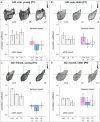Comparing the development of cortex-wide gene expression patterns between two species in a common reference frame
- PMID: 36201538
- PMCID: PMC9564327
- DOI: 10.1073/pnas.2113896119
Comparing the development of cortex-wide gene expression patterns between two species in a common reference frame
Abstract
Advances in sequencing techniques have made comparative studies of gene expression a current focus for understanding evolutionary and developmental processes. However, insights into the spatial expression of genes have been limited by a lack of robust methodology. To overcome this obstacle, we developed methods and software tools for quantifying and comparing tissue-wide spatial patterns of gene expression within and between species. Here, we compare cortex-wide expression of RZRβ and Id2 mRNA across early postnatal development in mice and voles. We show that patterns of RZRβ expression in neocortical layer 4 are highly conserved between species but develop rapidly in voles and much more gradually in mice, who show a marked expansion in the relative size of the putative primary visual area across the first postnatal week. Patterns of Id2 expression, by contrast, emerge in a dynamic and layer-specific sequence that is consistent between the two species. We suggest that these differences in the development of neocortical patterning reflect the independent evolution of brains, bodies, and sensory systems in the 35 million years since their last common ancestor.
Keywords: brain development; brain evolution; cortical arealization; evo-devo; neocortex.
Conflict of interest statement
The authors declare no competing interest.
Figures



Similar articles
-
Distinct actions of Emx1, Emx2, and Pax6 in regulating the specification of areas in the developing neocortex.J Neurosci. 2002 Sep 1;22(17):7627-38. doi: 10.1523/JNEUROSCI.22-17-07627.2002. J Neurosci. 2002. PMID: 12196586 Free PMC article.
-
Early postnatal gene expression in the developing neocortex of prairie voles (Microtus ochrogaster) is related to parental rearing style.J Comp Neurol. 2020 Dec 1;528(17):3008-3022. doi: 10.1002/cne.24856. Epub 2020 Jan 24. J Comp Neurol. 2020. PMID: 31930725 Free PMC article.
-
Rapid Changes in Cortical and Subcortical Brain Regions after Early Bilateral Enucleation in the Mouse.PLoS One. 2015 Oct 9;10(10):e0140391. doi: 10.1371/journal.pone.0140391. eCollection 2015. PLoS One. 2015. PMID: 26452243 Free PMC article.
-
Neocortical areas, layers, connections, and gene expression.Neurosci Res. 2006 May;55(1):11-27. doi: 10.1016/j.neures.2006.02.006. Epub 2006 Mar 20. Neurosci Res. 2006. PMID: 16546282 Review.
-
The evolution of brains from early mammals to humans.Wiley Interdiscip Rev Cogn Sci. 2013 Jan;4(1):33-45. doi: 10.1002/wcs.1206. Epub 2012 Nov 8. Wiley Interdiscip Rev Cogn Sci. 2013. PMID: 23529256 Free PMC article. Review.
Cited by
-
Whole-brain comparison of rodent and human brains using spatial transcriptomics.Elife. 2022 Nov 7;11:e79418. doi: 10.7554/eLife.79418. Elife. 2022. PMID: 36342372 Free PMC article.
-
Layer-Dependent Effect of Aβ-Pathology on Cortical Microstructure With Ex Vivo Human Brain Diffusion MRI at 7 Tesla.Hum Brain Mapp. 2025 May;46(7):e70222. doi: 10.1002/hbm.70222. Hum Brain Mapp. 2025. PMID: 40317841 Free PMC article.

